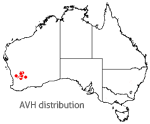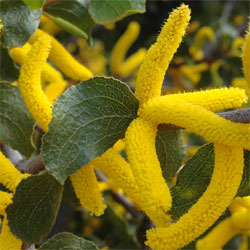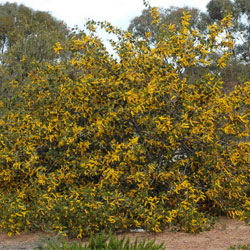Acacia denticulosa
Sandpaper Wattle
 Acacia denticulosa is a rare species of the Mimosaceae family. Acacia denticulosa’s common name ‘Sandpaper wattle’ is derived from the scabrous phyllodes which feel just like sandpaper to the touch.
Acacia denticulosa is a rare species of the Mimosaceae family. Acacia denticulosa’s common name ‘Sandpaper wattle’ is derived from the scabrous phyllodes which feel just like sandpaper to the touch.
A hardy, drought tolerant plant, Acacia denticulosa is listed as vulnerable on the EPBC ACT 1999. Its current distribution ranges east of Mt Churchman, south to Nungarin and west to Wongan Hills in south western Western Australia. Its natural habitat in this drought prone area is on granite hills and outcrops with shallow sandy soils with little water upkeep.
Acacia denticulosa is a unique species of wattle tree with respect to its morphological features. One could desire this plant to admire purely for its foliage. Its ‘leaves’ are actually phyllodes, flattened petioles which replace the blades of the juvenile leaves. The phyllodes are ovate, 5-9cm in length and 4-8cm in width, bear reticulate venation, have denticulate margins, are thick, scabrous and a vibrant dark green.
An open shrub, Acacia denticulosa will grow 1-4metres in height and up to 3m in width. It responds extremely well to annual pruning of the tips which results in a more dense, bushier habit. Butterflies and seed eating birds will be attracted to it when in flower and seeding. Small birds may also use this shrub as a refuge. Acacias also have a symbiosis with Rhizobium spp. nitrogen-fixing bacteria which are vital for soil health and provide nutritious soil for other plants to grow.
Acacia denticulosa will flower from the end of through to early Summer. It has stunning, golden yellow, 3-8cm long rod shaped inflorescences, borne at the leaf axis. The fluffy appearance is created from the many stamens extending out above the short petals of each of the clustered flowers on the inflorescence. In flower, your Acacia will be the star of your garden. Acacia denticulosa is a quick grower and will flower in its first year and annually there after. You can expect to enjoy your Acacia for up to 10 years.
For successful propagation of your Acacia, grow from seed not cutting. Most Australian native nurseries or online suppliers will supply this seed. Soak seed for 48hrs then sow in coarse riversand or potting mix. Keep moist but not wet. Germination should occur within 5-15 days.
Once Acacia denticulosa has germinated, move it to a sandy potting mix with excellent drainage. Grow it in the sunniest spot in your garden since this species thrives in full sun. A humid climate may be the main limitation to the successful cultivation of this species. Northern coastal areas won’t be the most favourable climate as Acacia denticulosa naturally grows in a dry area with little water. This Acacia will tolerate frosts down to -7°C. Several young Acacia denticulosa plants are growing very well in the Australian National Botanic Gardens in Canberra and will tolerate a variety of climates within the limitations listed above.
Text by Sarah Mannel (2012 Student Botanical Intern)
Name Meaning: Acacia denticulosaAcacia — from the Greek word 'akis', meaning point or barb denticulosa — derived from the Latin word 'denti'; meaning ‘tooth’, referring to the denticulate margins on the phyllodes |
References
Caban, S. (2012) ANBG Horticulturalist, pers. comm..
Department of Sustainability, Environment, Water, Population and Communities (2012) Acacia denticulosa in Species Profile and Threats Database, Department of Sustainability, Environment, Water, Population and Communities, Canberra. http://www.environment.gov.au/cgi-bin/sprat/public/publicspecies.pl?taxon_id=20600. Viewed 10 February 2012.
Descriptions by the Western Australian Herbarium, Department of Environment and Conservation. Text used with permission (http://florabase.dec.wa.gov.au/help/copyright). Accessed on Friday, 10 February 2012.
World Wide Wattle (2009) Acacia denticulosa, CSIRO publishing, Australian Biological Resources Study, Canberra, and the Department of Conservation and Land Management, Perth. http://www.worldwidewattle.com/speciesgallery/denticulosa.php?id=3293. Viewed 10 February 2012.
Wrigley, J.W. & Fagg, M. (1996) Australian native plants: propagation, cultivation and use in landscaping, Reed Books, Chatswood, N.S.W.
![An Australian Government Initiative [logo]](/images/austgovt_brown_90px.gif)



